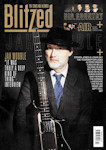
|
Front Cover
Large colour photo of Jah Wobble
"It was a truly deep kind of thing" Interview
INSET PHOTOS: BIG COUNTRY
"We made the music we wanted to make"
+
AIR - Moon Safari Adventures
+
Steven Jones & Logan Sky
The Teardrop Explodes
Altered Images
Tubular Bells
Talking Heads
Pet Shop Boys
Dead Or Alive
Duran Duran
Gary Numan
The Damned
Landscape
The Police
Midge Ure
Soft Cell
BEF
|
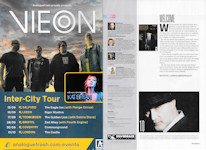
|
Pages 2 & 3
WELCOME
With the release of a much-overdue retrospective on pyschedelic pop outfit The Teardrop Explodes, this issue cass an eye over the
new box set Culture bunker. At the same time, it provides an opportunity to celebrate some of the Liverpool band's memorable moments, from singles to B-sides and rarities.
But we also spend time assessing some other classic 1980s acts this issue, including David Bowie, Altered Images and The Police. We
speak to rock outfit Big Country about their classic album Driving To Damscus. Meanwhile Jah Wobble talks to Blitzed with some illuminating anecdotes from
his own musical legacy, from PiL and beyond.
There's also an insightful interview with French electronic connoisseurs Air and things get brought up to date as we speak to Steven Jones and Logan Sky ahead of the
release of their evocative new album Sacred Figures.
We also have plenty of live coverage with Blitzed reporting on Duran Duran, Gary Numan, Midge Ure and The Damned. So there's plenty of engaging features to enjoy in this
packed issue of Blitzed!
Paul Browne / paulbrowne@blitzedmag.com
|

|
Pages 4 & 5
CONTENTS
14 Big Country Interview
28 Let's Dance at 40
66 Big Country: Driving To Damscus
84 Midge Ure Live
Photos:
84 Midge Ure / 14 Big Country / 88 Neil Scott / 10 Jah Wobble / 86 The Damned / 20 Air / 32 Steven Jones & Logan Sky
|
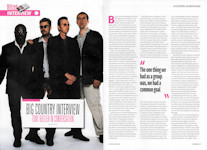
|
Pages 14 & 15
BLITZED INTERVIEW
BIG COUNTRY INTERVIEW
TONY BUTLER IN CONVERSATION
By Kevin Burke
Big Country effortlessly dominated the eighties and nineties. "I was very lucky to be in such a great band," recounts bassist Tony
Butler today, "I don't look back too much but when I do it is with great fondness for what we achieved. Because of the music we were making, we made the music that
we wanted to make, and we were a band in the style and the fashion we wanted to be. We were not your run-of-the-mill Pop or Rock band. We just became very well known,
and we were not Rock Stars or anything like that, and that's because most of what we were about was about being creative, it's that simple."
That is an enduring fact, in how Big Country was in essence relatable to the working classes. The band was formed in 1981 by former Skids' vocalist and guitarist Stuart
Adamson along with guitarist Bruce Watson. However, a year later they recruited the permanent rhythm section in Tony and drummer Mark Brzezicki, and this formative lineup
would last eighteen fruitful years, Throughout that career there were no pretentious motivations, and from a fans point of view they not other worldly, they were four talented
lads who could make addictive music together. "That is what we set out to from the beginning really. Again, trawling my memory; when I first met Stuart Adamson, it was when
myself and Mark were in a band called On The Air and we supported The Skids on their last tour with Stuart. I became quite friendly with Stuart on that tour, and realized what
kind of a guy he was. He certainly was not; an outwardly going, I want to be a Rock Star, I want to be famous, I don't want to care about anything. He was a very studious
guy, and serious about music, but he was very normal about life. It was the way I saw myself at the time anyway."
Continuing, and in some ways pointing at the chemistry of the four musicians, Tony examines the simple ethos of the band further. "People get involved in music for so many
different reasons, and they are probably more about self promoting and self achieving then(sic) they are about a common goal. The one thing we had as a group was, we had a
common goal. We were drawn in from the four corners of the kingdom, to become that band. It is kind of weird to have that all worked out."
Why Big Country is important in the scheme of music, is for their string of albums and singles that dominated the charts. Releases such as The Crossing, The Seer, and Steeltown
(the latter hitting number one), and songs such as 'Look Away', 'Wonderland' and 'Fields Of Fire' quickly built a fanbase and created anthems for the everyday, an escapism
that was not any fantastical journey. With a blending of Celtic Rock, New Wave and Post Punk sounds, Big Country provided something new to the charts, which indeed saw them
support such acts as U2, Queen, David Bowie, The Rolling Stones and even The Jam on their farewell tour.
Regardless of all this success, there was one thing that also set Big Country apart from many of the bands of the day, and that was how Little attention was ever
"The one thing we had as a group was,
we a had a common goal"
given to the band in terms of scandals or coverage outside of the music they created, "I would hasten to add it was to our detriment not to play the Pop Star game. During the
eighties and nineties, in order for record companies to sell records, they needed things to be as outlandish and avant-garde as possible to get publicity mileage, That is one
thing they were never going to get from a band like Big Country, Yes, we did interviews, we did photo sessions like everyone else, but we did not do that Pop/Rock Star thing
that took away from the importance of the band in terms of its music. Other people have really created their careers through everything but the music. The music is kind of
secondary to their own sort of personalities and their ambitions. None of us in the band had any sort of personality or ambitions, we just loved being in that band. Everytime
we would hit onto a stage, we loved being in that band - we had the best seats in the house, a fantastic feeling. But when we were off stage, it was never about cavorting in
public, and trying to make idiots out of ourselves in order to get press - inches in papers and all that stuff. Which is what record companies really wanted and I think in the
mid-career of the band record companies struggled with this in terms of the band. We just wanted to make great music, and they wanted us to recreate The Crossing and wear
frilly clothes and have weird hairstyles."
Big Country in their original incarnation lasted until the dawn of the 21st century. After eight albums from 1983 to 1999, the band started to wind down. The 'Final Fling'
tour saw them play sold out shows in Glasgow, and indeed their final show in gig in Kuala Lumpur, Malaysia, in October of 2000. But what followed was tragedy with the loss of
Stuart Adamson in December 2001. In many ways the last recording Big Country made and released in 1999, the ethereal and absorbing Driving To Damascus, remains a testament to
the final days of the band. Of the music contained on the album, there is also an emotion looking back in that it would become the last time Stuart would write and record with
his bandmates. "I remember thinking, when we were recording Driving To Damascus, where we were probably in terms of a band, we sort of went down the scale and sort of started
to come up again. And we were all incredibly fused when we were recording Driving To Damascus. We felt that we were still producing new music in the style of the four of us,
but things were improving with age."
"Stuart's lyrics on Driving To Damascus are phenomenal" Tony declares with an obvious pride. To be fair the collection of twelve tracks displays a range of styles and themes
which use nuances of different genres, but together create something unique. "l think on 'Your Spirit To Me', it is one of the high points for me lyrically. But the actual
title track 'Driving To Damascus' was the closest Big Country did, that made me fall completely and utterly in love with T.Rex again. It has
|
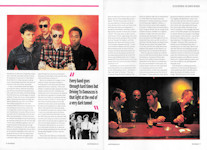
|
Pages 16 & 17
that feel to it, and I am a huge Marc Bolan and T. Rex fan, and when we did 'Driving To Damascus' it had such a T. Rex (Glam Rock) feel to it I knew we were making music
that people would like. We were so infused at the time of the recording."
It was a rejuvenated band that began to tackle the album, both the recording and writing. Something Tony looks back with a genuine fondness, and that feeling that the band
was excited again is clearly evident. "It was nice to be in that position again. Like every band goes through the album doldrums, you put a lot of effort into writing songs
that are not even received (well) and record companies are not putting as much as they could into it. You get into a music business trough, and sometimes it is really
difficult to pull yourself out of it artistically, and not let it affect you personally. I think by the time we started recording Driving To Damascus, we had just come out
of a bit of a low ebb I think. Even putting it together was a bit tough because we were going through different circumstances in life, and Stuart had just moved to Nashville,
and we did a lot of writing in Nashville, which was not so good for me as I did not really enjoy the experience. But we managed to get a fantastic album out of it. Every band
goes through hard times but Driving To Damascus is that light at the end of a very dark tunnel that we were in."
Not to be mistaken for hunger, or any need to create, the album marked a turning point in the band and how they approached their creativity. "There was always a creative
hunger, because we were always creative and our creativity was measured more in the amount of material we rejected as opposed to actually used. We were very harsh on ourselves
and we knew we had to conform in some way on the lines of commerciality, but we still wanted to make what would essentially be seen and recognised as a Big Country album. The
band in its individual state, we combined to make such a great noise. I mean we could play twelve bar Blues and it would still sound like Big Country. We didn't play the same
as everyone else, we were just unique as a band, and had a style. When we put the album together we also had the great addition to the team of producer Rafe McKenna. He came in
as a real breath of fresh air in terms of just throwing everything into the mix and seeing what happens. It was a real fun time for us."
"Every band goes through hard times
but Driving To Damascus is that light at the
end of a very dark tunnel"
That sound and influence of Nashville found its way onto the album. Some tracks have an Americana flavour, but it is just a flavour as it is a thoroughly Big Country album.
"It's like being a good cook. You can use essences of spices and herbs from all around the world, but if you cook with the same flame and approach, it should be identifiable,
and that is what Big Country was like in terms of a musical cuisine." That said, there is still a sound reminiscent of their beginnings, that Celtic Rock sound which springs
to life on songs such as 'Trouble The Waters', and that stretches into Rock and humour on the 'The President Slipped and Fell'. "I mean 'The President Slipped and Fell', people
felt sometimes that we were a bit too serious, but there were times where we just like to turn the guitars up too loud and play them as loud as we could. And that is one of
those tracks. But it makes sense and it has a bit of poetry to it, it has a great story to it and it has lots of Gibson Les Pauls on it."
Something not many know is how the Kinks' Ray Davies has songwriting on two of the album tracks - 'Somebody Else' and 'Devil In The Eye'. "That was a mutual thing. We were
invited by Ray Davies to perform with him at Glastonbury in, I think 1997. From that he became interested in initially producing, and then he and Stuart got together, I believe,
in New York and put some tracks together. For Stuart I imagine that must have been a fuckin' huge accolade. You do not get to be a British musician, whether it is England,
Scotland or Wales and not know about somebody like Ray Davies. The man is just a living Rock and Roll legend. And the songs that they came up with, we did not play them like
Ray Davies, we played them like Big Country would. We played them in our way, and the two songs they wrote together that appear on the album, it is Ray Davies but it is still
about the band."
There is a genuine reason as to all this focus on that time and that album Driving To Damascus. Courtesy of Cherry Red Records, fans of Big Country now get a celebration of
the album in a lavish four-disc box set (reviewed in this issue). The original twelve tracks are now expanded to a whopping seventy-two, which comprises demos, rarities and
expanded notes on the process around the birth of this classic, "I know what you mean about going from twelve to seventy-two (tracks). I am slightly old fashioned, I mean I am
sixty-six years old now, and there used to be a time when if you were in a band and did a demo, the only people that heard that demo were either the band or the record company,
or the manager. But then came a time when people not only started to release demos, but people's recordings would appear on the internet. I remember being sent through an email,
a clip of my bass playing on 'In A Big Country' solo, I thought; "Hang on! This is sacred, you should not be listening to this, this is something for our ears only". But it is
all over the internet and nothing is sacred anymore. So why not put all that stuff in a collector's hands so that they can actually enjoy the finished product and the track
being formulated, and different versions. Yeah so it is a great collector's piece, and I am not so rigid on my old-fashioned thoughts now."
One thing that is striking about this collection, is how Driving To Damascus could easily have been a double album given the amount of quality, unused songs. "We did record
a lot of songs
|
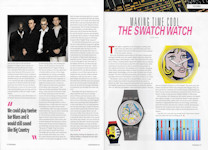
|
Pages 18 & 19
around that period. We had demo sessions in England, demo sessions in Nashville, and everything took shape over a period of time. But we wanted to make sure, because of the
slump in the nineties the band had in terms of albums and album sales, we wanted to make sure whatever we put out we could stand by in our normal way. Also, to give people a
perspective of what the band was at that particular time (which the box set does). All records are a record of the band at the time, and everything was buzzing until the crap
that befell us with the single 'Fragile Thing'."
"We could play twelve bar Blues
and it would still sound like Big Country"
As Tony mentions, a lot of the failure of Driving To Damascus becoming embraced by the buying public, and climbing the charts, can be placed on the lead CD single withdrawal of
'Fragile Thing' by the record company. The story goes that a limited-edition version of the single was withdrawn for having a packaging error (one cardboard fold too many) in
accordance with the Chart regulator. In turn shops withdrew all editions of the single by mistake, hence a knock-on effect happened where the promotion of the album was
concerned. "That killed practically everything. That whole thing, I mean we had tremendous hope for Driving To Damascus the first-time round. We were looking at doing as much
touring as we can, going back to America, re-establishing ourselves out there, but because that single failed in such a disastrous way, it really blew the wind out of the Big
Country sails unfortunately!"
Nevertheless, after the tragic passing of Stuart Adamson, Tony set about mastering a new edition of Driving To Damascus for the American market. Renamed John Wayne's Dream,
this version arrived in 2002 and featured four extra tracks, two of which featured The Raphaels, a short-lived project formed by Stuart Adamson and Nashville musician Marcus
Hummon. "Because of 'Fragile Thing' the album did not do what it should have done. The single did not chart, and I would not say our heads went down, but I know for certain
Stuart's head went down for certain. It is not about struggling, it is the want to keep achieving, which is a human response to a situation like that. But there was no way
for us to climb out of that hole we fell into, it was seriously bad. When we went back to look at John Wayne's Dream, it was because 'Yes!' Driving To Damascus could have
been a double album, and there was a lot of material that did not fit, and the record company was certainly not going to let us release a double album at that time. But the
pressure definitely dropped after 'Fragile Thing' stopped."
The thankful thing about this upcoming box set is how all these songs are together under one musical roof. Songs people may not be familiar with and may not have heard before
such as the John Wayne's Dream bonus material. Further, and more importantly, the set fondly shows how the dynamic of Big Country still was as powerful as ever. "Anyone that
invests in it, not only gets to hear the music in all shapes and forms, but they also get an idea of where the band was - where we were as people as well as musicians. We
stoked the fire, we did not reinvent ourselves or any of that crap, we just re-stoked the fire, and the embers needed pushing on a bit. And we were in really good shape. But
yes this box set, when I was told Cherry Red Records were going to put it out, it kinda made me feel that the story can be told. Not through interviews or comments, but
through the music end of it."
That aside, Driving To Damascus is an album that the band were incredibly proud of then, and that emotion still remains, and rightly so. "Absolutely! It can be too much of
that Rock and Roll legend when every band says their latest album is their best album. For us it was because we had been through a couple of albums, and we didn't want to
let ourselves down and not put out a good album, but we were just a little more intense for Driving To Damascus to put the band back where it should be. Not in the public
mind, but in the band's own minds. I am not one for re-releases, but this time I would love to see that people will get a concept of where the band was, how happy the band
was, if anything the happiness inside of Stuart on that record."
Big Country: Driving To Damascus, 4CD Deluxe Edition is released 30 June 2023 via Cherry Red
|
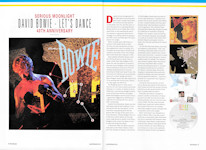
|
Pages 28 & 29
SERIOUS MOONLIGHT
DAVID BOWIE - LET'S DANCE
40TH ANNIVERSARY
By Paul Browne
Despite being reinvigorated by his 1980 album Scary Monsters (and Super Creeps), David Bowie's musical journey seemed to slow down
over the next few years. In part, this was due to a growing dissatisfaction with his record label, RCA. At the same time, he was awaiting the expiry of a severance agreement
with former manager Tony Defries (which by September 1982 would see Bowie gain full rights to any new songs).
Bowie actually spent 1982 firstly on a break in the South Pacific to bide his time, but also taking time out from this sabbatical to return to acting. This included war drama
Merry Christmas Mr Lawrence and erotic horror The Hunger which were both later released in 1983.
Now suitably refreshed, Bowie could turn his focus back on music. Keen to make a fresh start, Nile Rodgers of the band Chic was recruited to co-produce the next record.
Rodgers came onboard with an impressive resume as Chic had chalked up phenomenal hit records including 'Le Freak' and 'Good Times'. But his production talents also encompassed
acts such as Sister Sledge and Diana Ross. Rodgers would also later expand his CV by working with Duran Duran, Madonna, Lady Gaga and Daft Punk.
The fledgling ideas for what would become the Let's Dance album saw Bowie drawing on a number of rhythm & blues influences. Learning that Rodgers shared a love of the same
artists encouraged Bowie that Rodgers was the smart choice. "I guess that triggered me off thinking it might be fun working with him", Bowie later commented.
Despite his enthusiasm, Bowie was also well aware that he had to deliver a commercial hit with the new album. It can't have been easy getting back into the groove after the
gap of two years since Scary Monsters. Initially, Rodgers flew out to Montreux where Bowie ran through some rough demos on guitar. From there, Rodgers could conjure up ideas
on how to whip the songs into shape.
In December 1982, the album sessions took place at the Power Station in New York City. Outside of taking on the talents of Nile Rodgers, Bowie was also keen to involve new
musicians. "I wanted to try people that I'd never worked with before, so that I couldn't predict how they were going to play" was how Bowie summed up this approach. This
included Texas blues guitarist Stevie Ray Vaughan as well as a selection of musicians chosen by Rodgers. Chic session musicians Rob Sabino and Sammy Figueroa were brought in
as well as drummer Omar Hakim from Weather Report and bassist Carmine Rojas, who had also performed for Stevie Wonder.
For the first time ever, Bowie only sang and played no instruments, "l felt I was becoming a little static with the kind of synthesiser-techno stuff I'd been doing" Bowie said
at the time, "I wanted to break away from that. Every few years I have to edefine what I'm writing." The sessions also moved at speed, which was typical of the way that Bowie
often worked. Almost everything was done in one take and Bowie knocked out his vocals for the album in just two days. Stevie Ray Vaughan's involvement drew particular praise
from Bowie, who was impressed with the guitarist's ability to "...become a midwife to a sound that I had ringing in my ears all year."
During the post-production of Let's Dance, Bowie also signed to EMI America, which freed him from the burden of being with RCA and also served another fresh start in tandem
with the album.
Musically, Let's Dance managed to present a perfect combination of dance-pop and rock with funk flourishes that slotted perfectly into the colourful music scene of 1983. The
title song (and lead single) had a brash and brassy delivery that couldn't fail to be a hit. Equally, Stevie Ray Vaughan's guitar solo gives the composition some extra weight.
When 'Let's Dance' was released as a single in March 1983, it was also accompanied by a memorable video that Bowie had shot in Australia with frequent video collaborator David
Mallet. Featuring two students from Sydney's Aboriginal Islander Dance Theatre, the video offered up commentary on culture and capitalism. Meanwhile, Bowie himself only appears
|
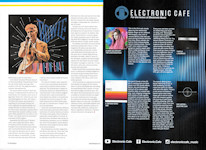
|
Pages 30 & 31
performing as part of a bar band.
'Let's Dance' knocked off Duran Duran's 'Is There Something I Should Know?' from the top of the charts, securing a No.l position in the UK, The single was also a massive
international hit.
The parent album arrived in April, featuring an intriguing series of choices in its track listing. This includes a slick cover of Iggy Pop's 'China Girl', which the pair had
recorded together for Pop's 1977 album The Idiot. Let's Dance also featured a reworking of 'Cat People (Putting Out Fire)', originally recorded by Bowie and Giorgio Moroder
in 1982 for the film of the same name. Although a spirited effort (with Stevie Ray Vaughan adding in some guitar fills), arguably the new take on 'Cat People' can't quite
match the dynamism and power of the original.
Meanwhile, the slick pop of 'Modern Love', which opens the album, offers an exuberant slice of power pop with energetic horns and soul touches. Bowie later commented that
the song's call-and-response elements were a nod to Little Richard. The third single release from the album, it reached No, 2 in the UK charts and was only kept off the No.
1 slot by Culture Club's smash hit 'Karma Chameleon'.
The video for 'Modern Love' opted for a much more conventional band performance shot on Bowie's Serious Moonlight tour. The song became a staple for ending live shows as it
allowed Bowie to "wave bye-bye" to the crowd as suggested by the lyrics. Later, to promote the Glass Spider tour, Bowie re-recorded the song with Tina Turner as part of a 1987
Pepsi commercial in which Bowie plays the role of a scientist who "creates" Turner in his laboratory.
'China Girl' showcases Bowie's ability to craft memorable pop hooks while exploring themes of cultural identity and desire. The songs sultry guitar riffs and Bowie's
passionate vocals added to its allure. At the same time, the album also serves up introspective moments, such as 'Without You' and 'Criminal World', where Bowie's distinctive
voice brings emotional depth to its lyrical narrative.
Also released as a further single from the album, the video for 'China Doll' had run into controversy. With footage of naked figures rolling around in the surf (a reference
to the film From Here to Eternity), the video was banned from New Zealand and some other countries at the time. Despite this, the single release managed a respectable No. 2
position in the UK charts.
Visually, the Let's Dance album also boasted a striking, bold cover. Bowie is photographed by Greg Gorman in boxer's pose against a stylised city skyline. Elsewhere, Derek
Boshier's artwork adopts the simple streetwise style of Keith Haring while Mick Haggerty's design touches lends the album a rough, earthy quality.
On release, Let's Dance received almost unanimous praise from critics. In Time magazine, the album was described as "unabashedly commercial, melodically alliterative and
lyrically smart at the same time", Charles Shaar Murray, writing for the NME, called it "some of the strongest, simplest and least complicated music that Bowie has ever made!'
The album managed to reach No. 1 in the UK charts, while also achieving similar success internationally.
Bowie himself later summed the album up as "a rediscovery of white-English-ex-art-school-student-meets-black-American-funk, a refocusing of Young Americans" (Bowie's 1975
album which trod similar ground).
There's perhaps an argument to be had that despite the appeal of Let's Dance, there's a sense that Bowie was eschewing his experimental side in favour of music that had its
edges smoothed down. But the album also demonstrated his uncanny ability to reinvent himself and adapt to an ever-evolving music landscape. Its commercial success also
solidified Bowie's status as a pop icon. The album's infectious hooks, danceable rhythms and Bowie's magnetic presence continue to resonate with audiences, making Let's
Dance a significant milestone in Bowie's already impressive discography.
|

|
Pages 66 & 67
BLITZED REVIEWS - DRIVING TO DAMASCUS
DRIVING TO DAMASCUS / Big Country
By Imogen Bebb
When Big Country first hit the UK music scene in 1982, wielding their rather marvelous brand of brash, energetic, often anthemic rock music.
The band went on to have numerous hits throughout the '80s and into the '90s with tracks like 'In A Big Country' (1983), 'Look Away' (1986), 'King of Emotion'(1988) and 'Alone' (1993),
mellowing less than one might expect as their career progressed and always managing to maintain elements of that typical Big Country sound.
By early 1999 the band had released seven studio albums and were in the process of recording their eighth in Wales' legendary Rockfield Studios. This album would eventually be titled
Driving To Damascus, and now 24 years later it's seeing a reissue as a deluxe 4CD box set comprising the original album, B-sides and alternate mixes, two discs of demos, and sleeve notes
by the band's manager at the time, Ian Grant, who reportedly gives a "personal insight into the album's genesis".
But before we even get started on the music, there's something specific about the history of this album that every listener should know - it was vocalist Stuart Adamson's last album
with the band before he sadly took his own life in 2001.
This might lead you to believe that Driving To Damascus is sad, melancholy or at the very least introspective, but in all honesty it's very rarely any of these things. In fact, you
could say it was the most powerful, upbeat, extroverted album Big Country had released for a number of years, and as such it's one of the strongest works put out by the classic line-up
(which also featured Bruce Watson on guitar, Tony Butler on bass and Mark Brzezicki on drums).
Take the title track, which also opens the album, which announces its arrival with a pealing guitar riff that descends into feedback noise backed up by a second, more rhythmic guitar
line and a clattering of drums. 'The President Slipped And Fell' takes a similar approach but with the added colour of a rock'n'roll-esque vocal line, whilst 'Devil In The Eye' is all
about the chorus harmonies and fuzzy Britpop guitars. On the lyrics front it's 'See You' that really shines, ditching the cheesy eagerness one might expect from story-telling love songs,
and instead serving up nuggets of wisdom about relationships that a lot of people will likely find themselves relating to.
There are a few moments of note elsewhere in the set, although it's the original studio album that's the obvious highlight; 'John Wayne's Dream' (the title under which the album was
released in the US) on disc two complements the studio album well with its wash of gritty guitars and genuinely memorable chorus, whilst the alternative mix of 'This Blood's For You'
on disc four has a heavy country feel, something which clearly suited the band's musical leanings at the time.
Overall, if you can cope with finding yourself constantly wondering why on earth Cherry Red didn't wait one more year and release it as a 25th anniversary edition, this set would make a
worthwhile addition to any early '80s or Scottish rock fan's collection. It also perhaps serves as a reminder that much of Big Country's music - even that which was released after what
could be considered their 'heyday - possesses a sense of longevity and persistent endurance that a great deal of music released by some of their contemporaries does not.
Big Country: Driving To Damascus, 4CD Deluxe Edition is released 30 June 2023 via Cherry Red
|
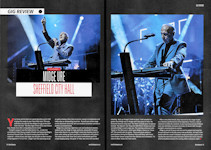
|
Pages 84 & 85
GIG REVIEW
MIDGE URE - SHEFFIELD CITY HALL
By Jan Blackwell
You know you've been to a great gig when you're still singing the songs in your head days later. This was definitely the case for the Midge Ure
gig at the Sheffield City Hall. The first night of the Voice and Visions tour, finally here after a long delay due to Covid.
Tonight's support was the India Electric Co, a male trio consisting of Cole Stacey, Joseph O'Keefe and featuring Midge's drummer Russell Field. The band mostly played their own material
- a kind of jazz, folk style, but did give us their version of Springsteen's 'I'm on Fire'. Singer Cole has stunning vocals as well as being a first-class musician, Joseph on keyboards
and violin also an outstanding musician. Russell was centre stage on his electronic drum kit. He's an excellent drummer and was a perfect accompaniment.
Midge Ure, wearing a light blue suit and turtleneck sweater, walked onto the stage to huge applause, along with the guys from India Electric Co, now Midge's band also looking smart in
their suits, taking up their positions on keyboards and guitars. The show starts with 'Dear God' which immediately gets the crowd singing along. The great 'If I Was' was next and sounded
amazing. Next up Visage's 'Fade to Grey'. I had actually forgotten that Midge was in Visage and it was great to hear. My favourite Ultravox song next; 'The Voice' actually gave me
goosebumps! 'No Regrets' and 'Reap the Wild Wind' showed just how versatile Midge's vocal range was. The evening continued with 'Death in The Afternoon', which gave Midge a chance to "show
off" (his words) with his guitar. There was great audience participation during the fabulous 'Pain and Glory' with loads more lesser-known songs from the Ultravox era in between. 'Visions
in Blue' closes the main event After a very short break, they returned to the stage to give us a fabulous performance of the legendary 'Vienna', a sea of cameras to video the moment. It
was haunting and just brilliant. Last, but definitely not least, the lively 'All Stood Still' brought tonight's amazing show to a close.
Midge is almost 70 years old now and he played and sang like he was still back in the 80s, every note perfection. He had a little banter with the crowd in between songs and made a point
in saying that the last three years had been hell for the music industry and he thanked everyone for coming. What a fabulous night!
|
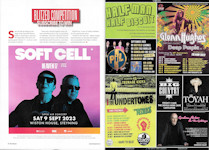
|
Pages 96 & 97
The Gig Cartel
Gig advert:
BIG COUNTRY
FRIDAY 4 AUG
THE DEVILS ARSE CAVE
CASTLETON
|





















